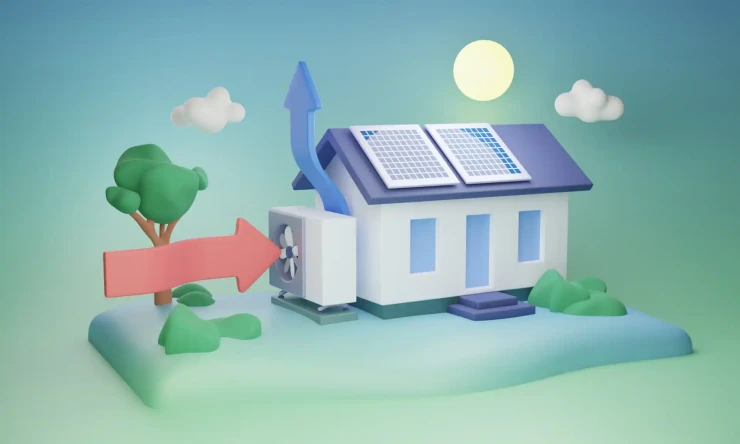
When it comes to making our homes eco-friendlier, we often focus on the big, visible projects – installing solar panels, buying an electric vehicle or renovating the kitchen with sustainable materials. However, some of the most impactful changes we can make are in the overlooked, utilitarian spaces of our homes. Though we don't spend much time thinking about our garage or loft, these spaces offer ample opportunities for green upgrades that make a collective difference to your home’s carbon footprint.
COMPARE PRICES FROM LOCAL INSTALLERS
Compare prices from local companies fast & free
Enter your postcode to compare quotes from leading professionals. We promise to keep your information Safe & Secure. Privacy Policy
Kitchen
The kitchen is the heart of any home, but it’s also one of the most resource-intensive rooms. Luckily, there are many easy ways to make your kitchen more eco-friendly without breaking the bank. Start by taking a look at your appliances.
As older appliances break down, replace them with energy-efficient models that meet strict efficiency guidelines. You can also install a tankless or on-demand water heater to reduce the energy needed to heat water. These compact units provide hot water only when needed, rather than maintaining a whole tank at high temperatures 24/7.
Incorporate large windows along the exterior wall to maximise natural sunlight, reducing the need for artificial lighting during the day. Homeowners can also choose eco-friendly countertop materials like bamboo or recycled materials which are durable and built to last. Use natural linseed oil or beeswax to treat and maintain wood surfaces to preserve them for longer. With a few eco-conscious upgrades, your kitchen can run more sustainably and also be healthier for your family.
Garage
The garage may seem like an afterthought, but it offers ample opportunity for green upgrades. An easy first step is switching out any regular incandescent lightbulbs for LEDs which use at least 75% less energy and last years longer, saving money and emissions over time.
When it comes time to replace your garage door, consider eco-friendly GRP (glass-reinforced plastic) doors. GRP is a durable, lightweight, and weather-resistant material made from a fibreglass and resin composite. Compared to traditional steel garage doors, GRP doors have excellent thermal insulating properties to prevent heat transfer. The material is also fully recyclable at end of life.
You can also make the garage more energy efficient by sealing any air leaks around doors and windows with caulk and weatherstripping. Adding insulation to the walls and garage door provides further improvements.
Windows
Passive solar design is an important sustainable building strategy that focuses on maximising the use of natural sunlight in a home. Through thoughtful orientation and layout of the house, passive solar design helps reduce the need for artificial lighting, heating and cooling.
The south side of the house should have significant glazing in the form of windows to allow sunlight to enter and provide heating. Avoid shading a south facade with trees, other buildings, or structures. Any garages should be positioned on the north side instead if space allows.
Another important element is using proper roof overhangs on the south-facing side. The eaves should be designed to allow in the low winter sun to provide heating while blocking the high summer sun to prevent overheating.
The layout of interior spaces should also align with passive solar principles. Living areas like the kitchen, dining, and living rooms should be placed along the south side to benefit from sunlight and solar heating. Utility rooms, bathrooms, and other less-used spaces should be positioned on the north side of the floorplan. Following passive solar techniques allows a home to truly capitalise on the natural benefits of sunlight, reducing energy usage for lighting, heating, and cooling.
Heating Systems
When selecting a heating system for your sustainable home, look for options that are energy-efficient and environmentally responsible. One green solution is to install eco-friendly radiators throughout your home.
Radiators provide space heating using hot water and convection without the need for fans or blowers. Modern high-tech radiators are compact and unobtrusive and circulate heat efficiently. Choose radiators made from recycled materials like cast iron or aluminium. These durable metallic radiators conduct and emit heat nicely.
To maximise efficiency, install thermostatic radiator valves on each unit. These allow you to control the temperature of each room or zone independently. Pair radiators with an on-demand boiler system that provides hot water only when needed. Consider connecting your radiators to a renewable heat source like solar water heating panels, a geothermal heat pump system, or even a wood pellet boiler or stove.
Radiant floor heating is another eco-option that works through hot water pipes or electric cables buried in the floor. This technique slowly and gently warms the room from the ground up. With sustainable heating choices like efficient radiators or in-floor radiant systems, you can keep your home comfortably heated while treading lightly on the earth.
Loft
The loft offers great potential for boosting your home's energy efficiency. Start by properly insulating between and over the ceiling joists to prevent costly heat loss in winter and heat gain in summer. Use sustainable insulation materials like sheep's wool or recycled denim batting. In hot areas, install a radiant barrier made of aluminium foil to reflect heat back into the loft space. Make sure to leave adequate ventilation for moisture control and consider adding a loft fan or ventilation system to remove excess warm air.
Insulate any loft hatches or doors to prevent drafts between living spaces. Seal any gaps or cracks around pipes, wires, and masonry penetrations with caulk or expandable foam. This prevents cooled or heated air from escaping.
When it comes to greening your home, it's easy to focus on the visible projects like solar panels or low-flow taps. But as we've discussed, some of the most impactful eco-friendly changes happen in the overlooked utilitarian spaces like the garage, loft, and more.
Small upgrades to these neglected spaces collectively make a tremendous difference in reducing your home's energy use, carbon emissions, and utility bills.
Take a fresh look at the forgotten corners of your home to spot savings opportunities. And don't underestimate the power of modest green improvements to underutilised areas – over time, the benefits really add up. With creativity and commitment, you can transform every room into a model of sustainability.
Find a local installer
Welcome to the biggest directory of UK renewable energy companies




























